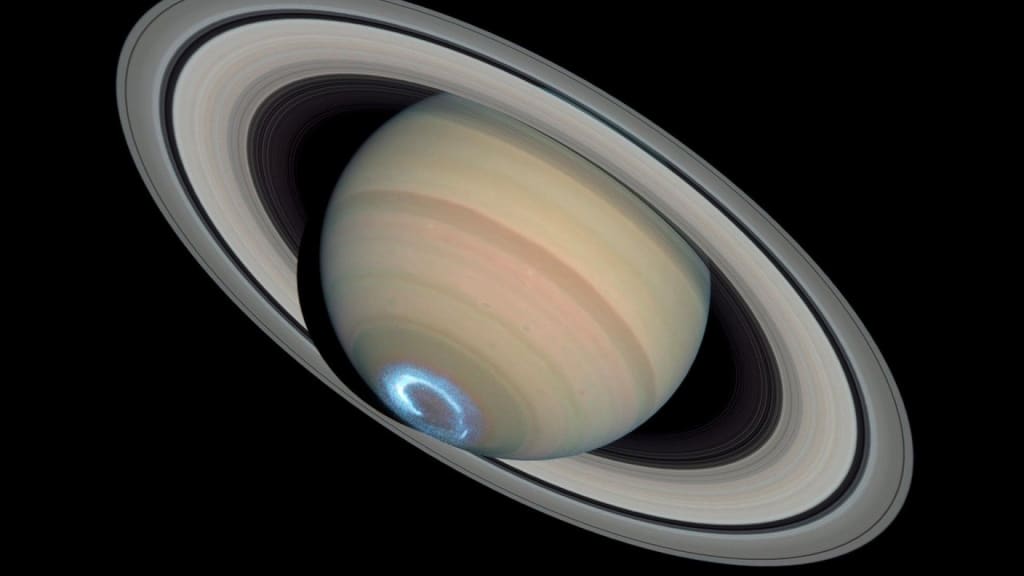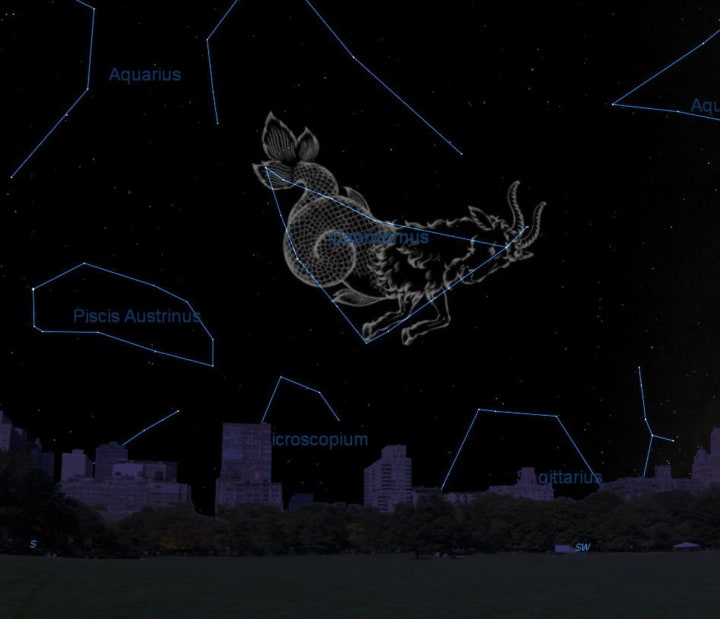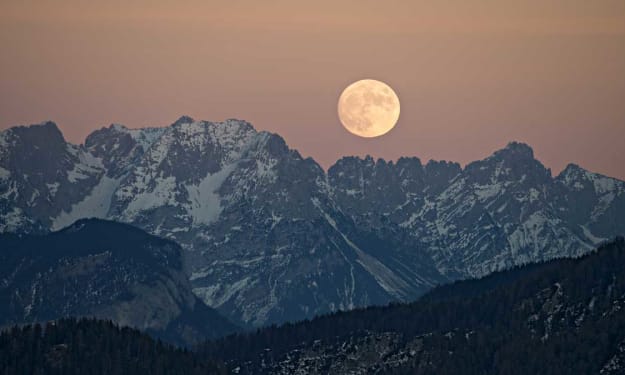Saturn in Capricorn
My Interpretation of the builder-sign in our Zodiac Reacting to the Planet of Structure and Rules.

It's difficult to say who discovered Saturn. It has always been visible to the naked eye in the dark of night. Galileo Galilei was the first to look through a telescope in 1610 and see Saturn's rings with Titan, one of it's many moons. These had disappeared for him later and chalked up to a trick of the eye. In 1659 it was a Dutch Astronomer, Christiaan Huygen, who saw Saturn's largest moon and he named it Titan. In 1675, Giovanni Cassini discovered 4 more moons orbiting this gas giant, as well as it's two largest rings and their gap. This gap is called 'The Cassini Division'.
Saturn, a gas giant of hydrogen and helium, is the sixth planet from our sun and the second-largest planet of our solar system. It is so dense that if there was a bathtub big enough, Saturn would float. It takes 10.5 hours to completely rotate on it's axis. This happens so fast, Saturn has a bulge at it's equator with winds that reach up to 1,100 mph. This has also caused the north and south poles of the planet to flatten.
There are at least 62 moons that have been discovered orbiting Saturn. Many more moons are constantly created and then destroyed. Some of Saturn's moons keep the rings in orbit by reacting with their material. Scientists used the data collected from our Cassini Probe and discovered that this gas giant produces powerful electron current. When particles from our sun hit the magnetic field of the planet, it creates Saturn's beautiful Aurora Borealis, like the one captured in the picture above. This electricity flows from Saturn to it's rings, and then in between it's rings. They theorize the magnetic flow is why mysterious spokes were discovered between the rings. These spokes form and disperse within hours. The rings also change in appearance due to asteroids and comets. Mysteriously, Saturn's F Ring appears to be braided. Scientists believe Saturn's massive gravity helped shape our solar system very early in its development. They're pretty sre Saturn threw debris toward the inner planets, like Earth, and hurled Neptune and Uranus outward. I wrote a blog on Uranus, which is in the sign of Taurus until 2026. Check out the little rebel of our solar system here!
Saturn in Mythology

Roman Mythology uses Saturn as the god of Agriculture, Civilization and Social Order. Saturn represents traditions and lessons from discipline, patience, responsibilities, and obligations that come with old age. This is a great planet for fall and winter! There is a time to plant and a time to harvest. We store what will be needed for the coming cold months of winter. During the Winter Solstice, there is a traditional celebration, and we share in the bounty of having made it through a dark, cold season. The Romans had Saturnalia, which starts December 17 and carries on until December 23. It is the turning point of the Sun in the sky, who is traveling through the constellation Capricorn, and Saturn's relation to the constellation. Saturn is strategic at balancing his roles as he teaches us. We learn patience and discipline, so we can indulge in the bounty of all our hard work. So long as we remember how we got it!
In Greek Mythology, Cronus, the king of time and one of twelve titans, ate his children to prevent himself from losing his throne to one of them. It's interesting to note that the mother of these powerful titans was named Gaia, which is another name for Earth. Cronus had already dethroned his own father, Uranus, a sky god. It's no small wonder he felt threatened by his own offspring, considering his own deeds. Cronus' wife, Rhea, managed to save the youngest, Zeus, by hiding him away on the island of Crete. She then tricked Cronus by giving him a rock wrapped in swaddling. I'm willing to bet some money, that for quite some time, Cronus probably felt a little constipated after swallowing a rock wrapped in cotton! Then again, being a powerful titan, and the ruler of time, he may not have even noticed how long that took!
Roman and Greek Mythology fit nicely with everything we have learned about the planet Saturn. It was visible to our human ancestors during the clearest nights of the long, dark winter season. It has had a very powerful effect on our solar system with it's gravitational pull, and the electricity it generates. Saturn governs limitations, responsibility, and boundaries. Titan is it's largest moon and the second largest moon that orbits any planet in our solar system. Titan's conditions are similar to Earth's earliest years, the only difference being that we are closer to our Sun and much warmer. We only know this from NASA's Cassini mission, which landed on Titan in 2005. Before that close-up study, it was just a happy coincidence for the Astronomer Christiaan Huygens to have named Saturn's largest moon Titan.
Saturn rules Capricorn and Aquarius
The planet Saturn rules two different astrological signs. Capricorn has been at the helm of a lot of my blog posts. This is because I have found that most of the outer planets have been transiting through the constellation recently. You can read my blog about Pluto in Capricorn here. Pluto moves into Aquarius directly after. In the beginning of 2020, Saturn will bounce between Capricorn and Aquarius, even going retrograde. Retrograde motion of a planet is when it slows down so much, it appears to go backwards in motion. It doesn't really, but this just means that whatever the planet is associated with will be affected, either positively or negatively. During July 2020, Saturn will finally stay in Capricorn until the end of the year. It takes roughly two years (maybe a bit longer, depending on it's retrograde) to transit through a sign. This planet is at home in both signs, so the bounce back and forth between them isn't necessarily a bad thing! You can recognize Capricorn, knows as the 'Builder-sign' of the Zodiac, by its oddly positioned crescent moon shape, resembling an outstretched bow amongst the stars.
Aquarius
Our sun travels through Aquarius from January 20 until February 18 (although this date changes when there is a leap-year) and is not just ruled by Saturn, but Uranus as well. Aquarius is one of the oldest documented constellations and was first documented by Greek Astronomer, Ptolemy, during the second century. The eleventh sign in the Zodiac, Aquarius, is located in the part of the sky known as 'The Sea'. In Astrology, it is associated with the element of Air, keeping Gemini and Libra company. Other constellations with water associated names, such as Delphinus (the dolphin), Pisces (the fish), and Cetus (the whale), can be found here. Aquarius, whose name in Latin means 'Cup-bearer' or 'Water-bearer', is depicted as a young man, pouring water.
In Greek mythology, Ganymede was a trojan who caught Zeus' eye. Being a god, Zeus then changed into an eagle. He carried the young trojan off home to the gods in Olympus, so the youth could become cup-bearer for them. So Aquarius is who pours life-giving water to all the other signs, so-to-speak.
Capricorn
Capricorn represents two types of goat: the Mountain-goat and the mythological Sea-goat. The Mountain-goat, a naturally sturdy and steadfast animal, is a climber like our Sun. The sun transits through Capricorn between December 22 until January 19. The Winter Solstice falls on December 21-22. Winter Solstice marks the period that our Sun has reached the lowest point in the sky and this is our shortest day of the year. Our Sun then begins it's climb back up, and our days begin to grow longer.
The Sea-goat has many different origins. It is a great representation for the constellation since they have the head of a goat and body of a fish, and live near shorelines, where the current depends on the tide and the terrain can be difficult. I guess this is why we have no evidence of them and we don't see them anymore...they must have become extinct once they evolved as land animals! Whichever tale (or tail!) you care for, the Sea-goat swims steady and assuredly, despite any difficulty. A Sea-goat mother tended to the infant Zeus while he was an infant and hidden on the island of Crete. In some myths, a Sea-goat by the name Pan (who was really a satyr), who has the head of a human on a goat-like body, helped Zeus defeat his father, Cronus. You may well remember reading about the war of the titans that ended in an epic, mythological battle. Which is ironic considering Zeus' father was supposed to have created the first Sea-goat.
The tail of the mythological Sea-goat represents the ease of moving swiftly through water. The melting snow of winter causes floods, and rain, and brings an end to the Winter season. Spring follows and with the suns longer days at warming the ground, Earth has new growth and fresh beginnings!
Saturn in Capricorn

In Astrology, planets and signs fall into gender categories according to their energies. Traditionally, the masculine is an extroverted energy and the feminine is more introverted. With masculine Saturn and feminine Capricorn, we can think of the two well-grounded, complimentary energies as our authority figures. In our Zodiac, Capricorn is the only feminine sign that is ruled by a masculine planet. Capricorn is the tenth sign of the zodiac, and that position means it is also governed by the Tenth House, which represents Honor. The Tenth House in Astrology is also thought of as the 'The Shaping Parent' or 'House of the Father'. This transit in 2020 is kind of perfect for the two of them. Capricorn keeps company with the other signs that have the feminine energy of Earth, like Taurus and Virgo, so there is naturally a tug-of-war going on with any masculine energy that transit through. However, the male-goat figure is all about ambition, hard-work, and commitment. Saturn tends to test limits and restrictions of order, using it's push-pull magnetism, to shape and mold. Capricorn has the perseverance to over-come the most challenging obstacles. With Capricorn receiving a two-year visit by its ruling planet, both planet and sign have a window of opportunity to get what's needed to be done...DONE. No excuses, no questions, just like all authority figures demand! Jupiter, who I deem the planet of Luck, has also joined Saturn in Capricorn after 30 years. But that's a blog I can share later!
Historically, whenever Saturn transits Capricorn, there's a lot that happens!
- In 1929, during a Saturn and Capricorn transit, the stock market crashed and we fell into a period called 'The Great Depression'. Our economy failed, the value of the American dollar fell, people went broke, hungry, and homeless. We had to change in order to survive.
- The U.S.vs Cuba during 1959 - 1962 was marked with the Cuban Missile Crisis, an entire Saturn in Capricorn transit. This event in history also intercepted the Cold War with Russia that ended in 1991.
- Another Saturn and Capricorn transit was happening during the fall of the Berlin wall in 1989.
- We had huge climate change issues that melted ice glaciers last year in 2019. Global Warming has been getting stronger over the decades.
- Here we are in 2020, already facing the doomsday clock ticking closer to midnight, the coronavirus pandemic, and a couple different countries having economic problems due to it.
Who knows what collaborative and visionary Aquarius is doing with this information? Since this sign has a masculine energy and is ruled by a neutral planet, I will refer to Aquarius as SHE. Aquarius has the life-giving waters for all the other signs, after all, and that is a nurturing mother in nature. She is also ruled by a planet that likes to be a creative problem-solver! She receives a visit by Saturn as well, in May and June, when Saturn turns retrograde in her sign, I bet her progressive thought process is insightful and creative in the coming few years!
Did you like what you read? If you did, why not leave me a tip? If not, you can check out my profile to see what else you like!
About the Creator
Lady Sunday
I'm a self-publishing author of fiction and I love to research and write creative non-fiction.






Comments
There are no comments for this story
Be the first to respond and start the conversation.